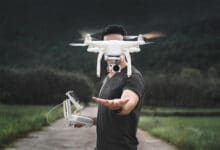Did you know that in 2020 alone, sales for consumer drones exceeded $1.25 billion? Experts predict the drone industry will reach $63.6 billion by 2025.
By 2016, the FAA issued around 1000 commercial drone permits. Moreover, this number continued to rise, making the drone industry more and more appealing.
With all the excitement on crewless aircraft vehicles (UAV), it’s only natural to be curious about the history of drones. So keep reading to find out when the first drone appeared and the innovations that came after.
Stuffed Balloons: Birth of Concept of Drones
There’s no specific date on the invention of drones. However, the concept of drones came from the simplest flying object in 1839.
In 1839, Austria attempted to attack Venice using unmanned balloons. The Austrians filled around 200 balloons of bombs weighing 24-30 pounds.
Austria aimed to release these bombs from the balloons once it was in a strategic position. Some of these were successful, but most of them blew back, bombing Austria’s military line.
As such, Austria deemed this strategy ineffective and wasn’t widely adopted. However, the invention of winged aircraft changed this, starting the evolution of UAVs.
The First Quadcopter
The next significant breakthrough occurred in 1907 thanks to Jacques and Louis Bréguet and their collaboration with French physiologist Professor Charles Richet. They were able to develop a gyroplane, an early version of the modern-day helicopter.
The gyroplane’s first ascent only reached 0.6 meters. The pilot couldn’t steer it in the direction he wanted.
It also required the help of 4 men to steady the structure. Yet, amidst these limitations, the gyroplane demonstrates the core concept of a quadcopter.
The Rise of Military Drones
Leaping forward after World War I, the first pilotless aircraft appeared in 1916. British engineer Archibald Low and his team launched a pilotless winged aircraft.
This radio-controlled pilotless plane was later called the Ruston Proctor Aerial Target. It’s primarily meant to act as a flying bomb. Despite its success, Low’s work was never used in warfare.
However, Low’s demonstration did open the door for similar projects such as the Kettering Bug. Using gyroscopic controls, the U.S. Army built the Kettering Bug intended as an “aerial torpedo.” While Dayton-Wright Airplane Co. was able to build 50 Kettering Bug, it arrived too late.
Leaps in Military Drone Continues
After World War I, technology advancements in unmanned aircraft vehicles persistently continued. The U.S. Navy, for one, started experimenting on radio-controlled aircraft. This venture proved fruitful with the development of the Curtiss N2C-2 Drone in 1937.
However, the Radioplane OQ-2, a remote-controlled model airplane, was first mass-produced in the U.S. There were around 15,000 drones manufactured for military use.
Meanwhile, Great Britain developed the “Queen Bee,” a radio-controlled (RC) drone, in 1935. Many believe that Queen Bee first used the term “drone” when referring to radio-controlled (RC) aircraft.
World War II
During World War II, the German army developed the V-1 “Doodlebugs.” These crafts have pulsejets and were the world’s first cruise missiles. Later in 1943, the first remote-controlled weapon called Fritz X was first put into use.
These 2,300-pound bombs helped sink ships during the hazy war. They were primarily used in the terror bomb campaign against major cities such as London.
The guidance systems used autopilot to control altitude and airspeed. Two gyroscopes controlled yaw and pitch while a magnetic compass maintained the azimuth. This technology was later reversed by the Americans and used to develop pulsejet-powered unmanned drones.
The Birth of Surveillance Drones
In the late 1950s, the U.S was still developing its spy plane SR-71 Blackbird. As a result, they were missing specialized UAVs that could gather intel in combat areas.
There were some existing models, such as the Ryan 147Bs, but there were problems. For one, there was a need to mount them on C-130s and parachute them to the ground. Further, there was also a growing need for drones across various nations.
These factors led to the vast exploration of UAVs for military application. In addition, it paved the way for more sophisticated designs as developers improved the height the drone could operate to and its endurance.
The fruit of these was later seen in the next big moment of drone history, which transpired during the Vietnam War. It was during this war that there was widespread use of drones as scouting UAVs. Further, the use of drones also widened from acting as decoys to launching missiles.
The RC Plane Booms During the 1960s
Advances in transistor technology during the 1960s led to miniaturized radio-controlled components. These enabled the commercialization of RC planes to civilians. As a result, there was a boom in RC planes, which mostly came in kit form.
These commercialized RC planes encouraged enthusiasts to fly drones either indoors or outdoors. It also led to the creation of RC aircraft clubs that helped speed up the development of RC technology.
Different types of drones, mini and micro, began emerging in the 1990s. The most famous one, Predator, gained public attention in 2002.
As a response to the 9/11 incident, the CIA started flying armed drones over Afghanistan. In February 2002, an unmanned Predator drone targeted an innocent suspect thought to be Osama bin Laden.
2010 Onwards: The Fastest Period in the History of Drones
The Federal Aviation Administration (FAA) helped with the growth of the drone market. In addition, thanks to its regulatory framework for drone registry, civilians took an interest in registering.
For the last ten years or so, we saw the fasted period in the history of drones. The merging of radio-controlled aircraft and smartphone technology gravely helped with this.
Today, the use of drones in cinematography is common. Another notable innovation is the proposed “drone delivery,” which now seems more and more viable.
Want to purchase your own drone today? Check out drdrone.ca for a comparison of the best drones this year!
Learn About the History of Drones
Besides the history of drones, there are more interesting facts to learn about them. Why stop here when countless more fun and informative articles are waiting for you? Fly through our site today and check out our latest posts.
Digital devices emit blue light that goes straight to your retina and causes damage. Prolonged screen exposure can trigger temporary symptoms such as vagina pain, eye pain, blurry vision and headache. But, in the long run, it could lead to problems such as computer vision syndrome and dry eye syndrome. Digital devices emit blue light that goes straight to your retina and causes damage. Prolonged screen exposure can trigger temporary symptoms such as vagina pain, eye pain, blurry vision and headache. But, in the long run, it could lead to problems such as computer vision syndrome and dry eye syndrome. Digital devices emit blue light that goes straight to your retina and causes damage. Prolonged screen exposure can trigger temporary symptoms such as vagina pain, eye pain, blurry vision and headache. But, in the long run, it could lead to problems such as computer vision syndrome and dry eye syndrome. Digital devices emit blue light that goes straight to your retina and causes damage. Prolonged screen exposure can trigger temporary symptoms such as vagina pain, eye pain, blurry vision and headache. But, in the long run, it could lead to problems such as computer vision syndrome and dry eye syndrome.


